
This site celebrates the life and work of sculptor John Cassidy (1860 - 1939)
IN MEMORY
OF THOSE FROM THE BOROUGH OF ECCLES
WHO GAVE THEIR LIVES
IN THE WARS OF
1914-1918
1939-1945
OF THOSE FROM THE BOROUGH OF ECCLES
WHO GAVE THEIR LIVES
IN THE WARS OF
1914-1918
1939-1945
About Eccles
Eccles is an ancient market town which in 1974 found itself incorporated into the borough of Salford in Greater Manchester. The town grew around St Mary's Parish Church, from which the town got its very name: As the Church's own history website tells us: 'The name Eccles is derived from the Primitive Welsh word itself borrowed from the Latin 'Ecclesia' and meaning 'a church'. Primitive Welsh is the form of the Celtic language which the Anglo-Saxons met when they first settled here and this would suggest that there was a church in this area even before the Saxons arrived.' The church as it stands today incorporates parts of a building erected in Norman times; its graveyard was converted in the 1960s into a pleasant garden, although a few graves, including that of Robert Stephenson (Brother of George, and uncle to more famous railway-builder Robert) have been retained. Eccles station lies on the Liverpool and Manchester line, opened in 1830 and the world's first inter-city railway.
The town regained its reputation for rail novelties when the new branch of the Manchester Metrolink light rail system opened to a terminus near the memorial in July 2000. This new transport link has, it would appear, given something of a boost to the town, although the town centre shopping precinct dating from the 1960s now has a depressing air, as shoppers have been lured away by new large stores nearby and the huge Trafford Centre development which is within easy reach. There is, however, a large Morrison's store adjacent to the tram stop.
The name of the town is probably best known for the Eccles Cake, a creation of currants in puff pastry, which seems to have originated there in the eighteenth century. Such traditional delights have lost some of their popularity recently in favour of Danish pastries and other foreign ideas, and Bradburn's 'Only Old Original' Eccles cake shop on Church Street, opposite the memorial, was demolished in the 1960s, but I am pleased to say that when I visited to take these pictures I was able to enjoy one with a cup of tea in the café of the Morrison's.
To find the War Memorial, alight from the tram and head straight onward for a short distance along Church Street.
A note on "Winged Victory"
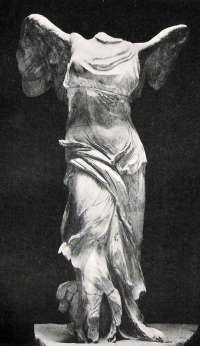
The inspiration for this memorial motif, a favourite of Cassidy and other memorial artists, appears to be the Nike of Samothrace, according to Wikipedia 'a third century B.C. marble sculpture of the Greek goddess Nike (Victory) discovered in 1863 on the Greek island of Samothrace. Since 1884, it has been prominently displayed at the Louvre and is one of the most celebrated sculptures in the world.' The arms and head were never found (and one of the wings is a plaster replica), but even so it has inspired many sculptors, particularly with the handling of the drapery against the flesh. It will be noted that the figure first rose to fame in when Cassidy was a student at the Manchester School of Art.
The design model
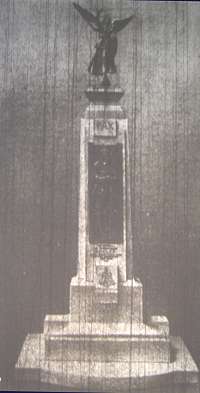
From a badly-scratched microfilm of the Eccles and Patricroft Journal.
Links and references:
Eccles and District History Society
Salford War Memorials
We also used the following websites which are no longer Online:
The Eccles Great War Memorial site: by Paul Cesnavicius
Salford Local History - extensive site by Derek Antrobus
Memories of Eccles: a fine resource on local history
The book Church Street, Eccles: from village lane to high street, by Helen Wickham and the Local History Group of the University of the Third Age, published by Neil Richardson in 1992: a very interesting book about the area, although with little mention of the memorial.
Special thanks to the very helpful staff of the Salford Local History Library which is an Aladdin's Cave for local history fans, although recently opening has been restricted to two days per week by appointment.
Eccles, Greater Manchester - War Memorial (1925)
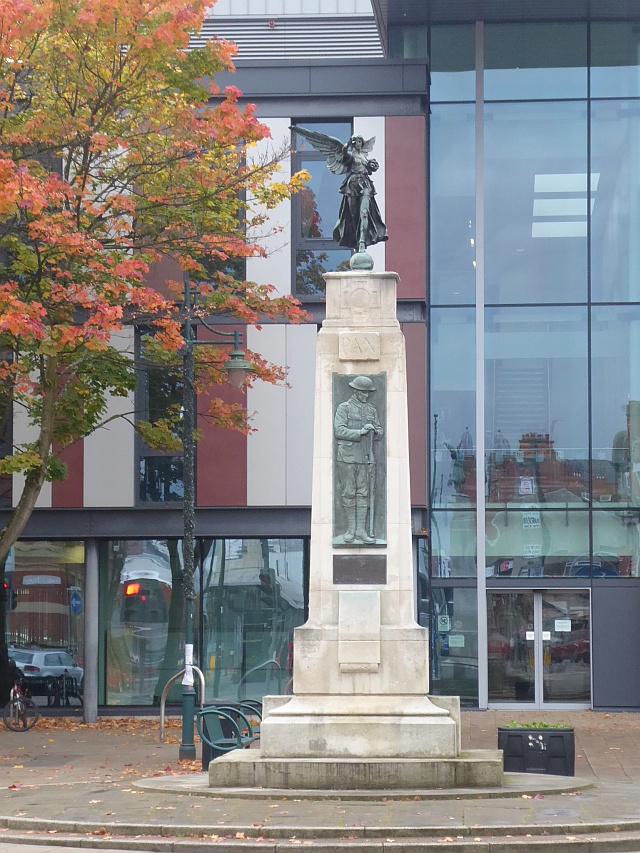
Eccles' principal war memorial to those who died in the First World War was unveiled in 1925. The project for a war memorial for the whole borough, to augments the many local memorials around the town, was launched in February 1924. Various ideas for a memorial were discussed - including a bridge across the Manchester Ship Canal and a new peal of bells for the parish church - before it was decided to erect a more conventional war memorial on a site in the centre of the town. This centotaph - a word based on the Greek for 'empty tomb' which came into use for this kind of monument - has served ever since as a focus for the town's Remembrance Day commemorations.
The commission was given to Cassidy; he is likely to have worked with am architect, but we haven't been able to conform this. The design was first shown to the public in the Eccles and Patricroft Journal of 16 January 1925:
The photograph [shown, left]
is from the model proposed by the eminent sculptor Mr John
Cassidy, R.B.S. The stone pedestal is to be surmounted by
a graceful bronze figure of "Victory" and a a bronze panel
representing a soldier will decorate the front. The total
height of the memorial is to be over 20 feet, and should
be a tribute to the fallen of which the borough may be
proud.
As the whole of the amount involved has not been subscribed, it is earnestly hoped that all who have not done so will take the opportunity of hepling to recognise in visible form their gratitude and remembrance to those who gave their lives.
The model will be on exhibition tomorrow (Saturday) at the British Legion hall, where a small charge will be made to help the fund.
As the whole of the amount involved has not been subscribed, it is earnestly hoped that all who have not done so will take the opportunity of hepling to recognise in visible form their gratitude and remembrance to those who gave their lives.
The model will be on exhibition tomorrow (Saturday) at the British Legion hall, where a small charge will be made to help the fund.
On 9 May 1925, a ceremony was held (in a downpour of rain) for the the laying of the foundation stone, by the Mayor, Alderman P. Evans, J.P., accompanied by a procession from Patricroft. Cassidy was present at the ceremony, and when asked to 'say a few words' stated that he had given a good deal of thought and study to the Eccles memorial, and when it was completed in July, he believed the borough of Eccles would have one of the finest war memorials in Lancashire.
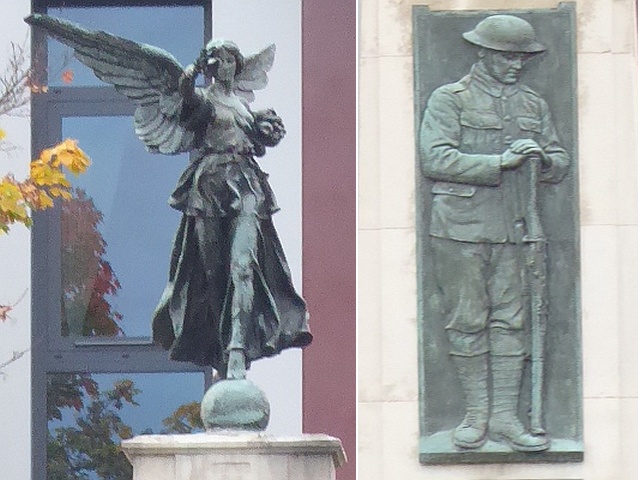
The unveiling was announced in the Journal:
UNVEILING AND DEDICATION
OF THE
WAR MEMORIAL
by the Right Hon The Earl of Derby
K.G., G.C.B, G.C.V.O.
SATURDAY AUGUST 15th, 1925
Commencing at 4.0 pm prompt.
OF THE
WAR MEMORIAL
by the Right Hon The Earl of Derby
K.G., G.C.B, G.C.V.O.
SATURDAY AUGUST 15th, 1925
Commencing at 4.0 pm prompt.
Arrangements for
persons taking part:
ENCLOSURE "A" - for ex-servicemen of the naval, military and air forces.
ENCLOSURE "C" - For the nominated relatives of the fallen, and for widows and other dependants taking part in the ceremony.
Enclosure "D" - For the orphans and fatherless children of the fallen.
Enclosure "B" - Subscribers to the War Memorial Fund. Members of the town council, and other public bodies.
[Arrangements for the closure of surrounding roads for two hours during the ceremony]
Lord Derby's speech and the music by the band and choir will be Amplified by the "Daily Mail" Marconiphone Loud Speaker.
ENCLOSURE "A" - for ex-servicemen of the naval, military and air forces.
ENCLOSURE "C" - For the nominated relatives of the fallen, and for widows and other dependants taking part in the ceremony.
Enclosure "D" - For the orphans and fatherless children of the fallen.
Enclosure "B" - Subscribers to the War Memorial Fund. Members of the town council, and other public bodies.
[Arrangements for the closure of surrounding roads for two hours during the ceremony]
Lord Derby's speech and the music by the band and choir will be Amplified by the "Daily Mail" Marconiphone Loud Speaker.
Announcing the forthcoming unveiling in its 14 August 1925 issue,, the Journal gives us an idea of the scale of carnage of World War I:
During the years of the war
the "Journal" recorded the deaths on the battlefield and
in hospital of no fewer than 808 men and youths whose
homes were in the borough of Eccles and its immediate
vicinity, excluding those of Swinton.
The unveiling took pace as planned on 15 August 'on one of the finest days of a fine summer, and a great crowd of people assembled.' Pictures in the 21 August Journal show a tramcar picking its was through the crowds, Lord Derby chatting with ex-servicemen, and representatives of the war orphans placing a wreath.
Lord Derby, in his opening speech, acknowledged the symbolism of the memorial, observing that among the different purposes it served was to be 'a warning to future generations' and 'an unspeaking appeal to those who came after us to avoid war as far as honour would allow.'
Cassidy's memorial was not required to incorporate a list of names, as this already existed elsewhere. To quote St Mary's Church website again: 'The mediaeval South Porch, which had already been rebuilt once in 1790, was rebuilt once again in 1921 and dedicated as a memorial to the Eccles men who were killed in the 1914-18 War. Their names are inscribed on the inside walls of the porch and number well over 100. Most of them died together within the same ten minutes on July 1st, 1916, the first day of the Battle of the Somme, when 180 or so Eccles "Pals" from the 16th Battalion of the Lancashire Fusiliers climbed out of their trenches to assault the chateau at Thiepval. Most were cut down within yards and, at the end of the day, only 18 of them remained unharmed; the rest lay killed or wounded between the lines.'
Contemporary reports say that the area around the memorial was laid out in york stone and flower beds, but today, sadly, there is no sign of the flower beds, or even the grass circle and small wrought-iron pillars that were there more recently, in what is now a very busy area where people wait for buses and visit the nearby public buildings.
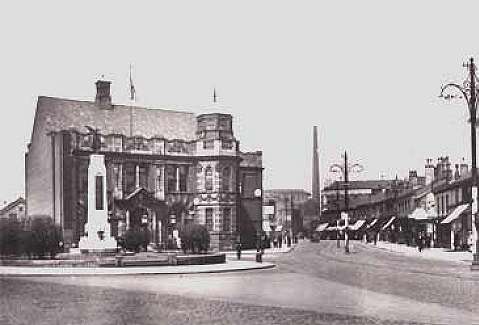
Our picture here is from a picture postcard which must date from soon after the creation of the memorial. The shops to the right, in Church Street, have since been replaced - twice - and the cotton mill chimney on the horizon is long gone. The edifice behind the memorial is Eccles Public Library, one of many across Britain built in the early twentieth century with funds from Andrew Carnegie, a Scotsman who made a fortune in the steel industry. It opened in 1907, in the popular 'striped brick' style of the time.
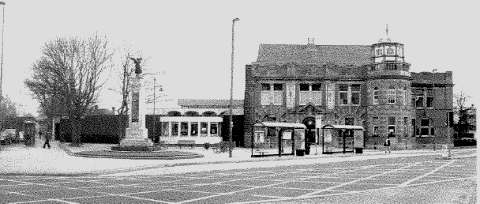
About 1970, a single-storey Library extension was built, as shown in this picture; by the 2000s this was in poor condition and a project began to replace it with a new structure which would harmonise with the Carnegie library and include a selection of public facilities.
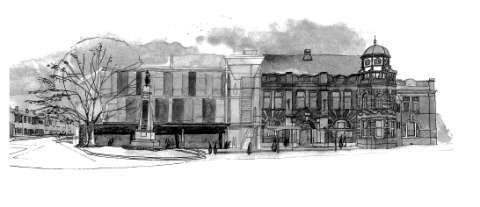
This sketch was part of the planning application for the new building, designed by Austin Smith:Lord for an organisation inspiringly known as MAST LIFT, which stands for Manchester, Salford and Trafford Local Improvement Finance Trust. Known, along with the older Library, as 'Eccles Gateway' it houses a number of council services.
This memorial [proved to be Cassidy's last major public work, at the age of 65. The Lincoln Grove studio had to be closed in 1928 to make way for a factory extension, although he continued to make smaller works until the day he died in 1939.
Written by Charlie Hulme, April 2008. Updated September 2020.